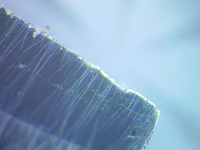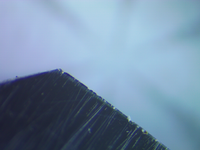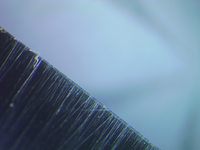If you were to look up my newbie intro thread, and I don't know why you should, you would find that I came to straight razor shaving out of an interest in sharpening. Sharpening a straight razor seemed like the ultimate challenge, and what good is that if you don't shave with it?
Naturally I have since discovered the pleasures of straight razor shaving, and I don't think a cartridge razor will be touching my face again. But, as a steel-and-sharpening man, I hungered to know what was going on with those edges. So I got a microscope.
I don't mean one of those "digital microscope" things you can get for $25 on Amazon. I had one of those, and I wasn't getting anything out of it that a 12X lighted loupe would not provide. I mean the real thing. It took me a while to learn the difference. "Digital microscopes" zoom in by increasing the size of pixels. Microscopes do that optically.
So I put a razor I've used a bunch under the microscope. This is a razor I've stropped on 0.1 micron pasted balsa after every shave, and stropped on leather before. I was not entirely prepared for what I discovered, which was edge damage from just shaving.
The heel:
 .
.
The toe:

The middle:

Yes, I use the heel and toe a lot. I have hollows in my neck. I didn't touch this razor on anything except my face. You can see what shaving did to it.
It's not unexpected. Facial hair is harsh. But it does seem to support the idea that you need to go back to the stones after a time of doing this sort of damage to the delicate edge.
Naturally I have since discovered the pleasures of straight razor shaving, and I don't think a cartridge razor will be touching my face again. But, as a steel-and-sharpening man, I hungered to know what was going on with those edges. So I got a microscope.
I don't mean one of those "digital microscope" things you can get for $25 on Amazon. I had one of those, and I wasn't getting anything out of it that a 12X lighted loupe would not provide. I mean the real thing. It took me a while to learn the difference. "Digital microscopes" zoom in by increasing the size of pixels. Microscopes do that optically.
So I put a razor I've used a bunch under the microscope. This is a razor I've stropped on 0.1 micron pasted balsa after every shave, and stropped on leather before. I was not entirely prepared for what I discovered, which was edge damage from just shaving.
The heel:
 .
.The toe:

The middle:

Yes, I use the heel and toe a lot. I have hollows in my neck. I didn't touch this razor on anything except my face. You can see what shaving did to it.
It's not unexpected. Facial hair is harsh. But it does seem to support the idea that you need to go back to the stones after a time of doing this sort of damage to the delicate edge.



